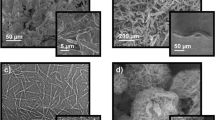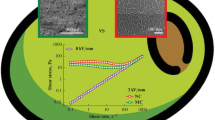Abstract
The performance of electrorheological (ER) fluids containing cellulose particles dispersed in lubricating oil was investigated as a function of particle water content, DC electric field strength, particle concentration, and temperature. Over a range of applied electric fields (0–3 kV/mm), yield stress was observed to increase with increasing cellulose moisture content up to 8.5 wt% followed by a decrease. Water adsorbed by cellulose particles used in these systems was shown to be non-freezing bound water. The maximum ER response for a cellulose-based fluid at 25 °C was observed at a moisture content near the transition of less mobile ‘liquid-like’ (LM) water to more mobile ‘liquid-like’ (MM) non-freezing water. At a constant moisture level, yield stress increased linearly with increases in either electrical field strength or particle concentration, while the ER effect decreased with increasing temperature. The present study concludes that the performance of water-activated ER fluids based on cellulose particles is influenced strongly by the mobility of non-freezing bound water adsorbed onto cellulose.
Similar content being viewed by others
References
J. Berthold J. Desbrières M. Rinaudo L. Salmén (1994) ArticleTitleTypes of adsorbed water in relation to the ionic groups and their counter-ions for some cellulose derivatives Polymer 35 5729–5736
J. Berthold M. Rinaudo L. Salmeń (1996) ArticleTitleAssociation of water to polar groups: estimations by an adsorption model for lingo-cellulosic materials Colloid Surf. A: Physicochem. Eng. Aspects 112 117–129
B. Blicharska M. Kluza (1996) ArticleTitleNMR relaxation in cellulose pulp Colloid. Surf. A: Physicochem. Eng. Aspects 115 137–140
H. Block J.P. Kelly (1988) ArticleTitleElectro-rheology J. Phys. D: Appl. Phys. 21 1661–1677 Occurrence Handle1:CAS:528:DyaL1MXos1Wrtg%3D%3D
C. Boissy P. Atten J.N. Foulc (1995) On the role of conductivities and frequency in the electrorheological effect W.A. Bullough (Eds) Proceedings of the 5th International Conference on Electro-Rheological Fluids, Magneto-Rheological Suspensions and Associated Technology World Scientific SheffieldUK 756–763
D. Capitani M.C. Emanuele J. Bella A.L. Segre D. Attanasio B. Focher G. Capretti (1999) ArticleTitle 1H NMR relaxation study of cellulose and water interaction in paper Tappi J. 82 117–124
D. Capitani A.L. Segre D. Attanasio B. Blicharska B. Focher G. Capretti (1996) ArticleTitle 1H NMR relaxation study of paper as a system of cellulose and water Tappi J. 79 113–122
Y. Chen H. Conrad (1993) Effects of water content on the electrorheology of corn starch/corn oil dispersions D. Siginer W. Van Arsdale M. Altan A. Alexandrou (Eds) Developments in Non-Newtonian Flows, Vol. 175 ASME New York 199–208
U.S. Choi H. Conrad (1998) ArticleTitleElectrorheology of chitin and chitosan suspensions: conductivity vs. molecular structure Rheol. Fluid Mech. Nonlinear Mater. MD 81 145–151
H. Conrad Y. Li Y. Chen (1995) ArticleTitleThe temperature dependence of the electrorheology and related electrical properties of corn starch/corn oil suspensions J. Rheol. 39 1041–1057
H. Conrad A.F. Sprecher (1991) ArticleTitleCharacteristics and mechanisms of electrorheological fluids J. Stat. Phys. 64 1073–1091
C. Czihak M. Muller H. Schober L. Heux G. Vogl (1999) ArticleTitleDynamics of water adsorbed to cellulose Physica B 266 87–91
L.C. Davis (1992) ArticleTitlePolarization forces and conductivity effects in electrorheological fluids J. Appl. Phys. 72 1334–1340 Occurrence Handle1:CAS:528:DyaK38XlsFOqu7Y%3D
Y.F. Deynega K.K. Popko N.Y. Kovganich (1978) ArticleTitleTemperature dependence of the electroviscous effect and dielectric parameters of suspensions of hydrated substances in hydrocarbons Heat Transfer-Soviet Res. 10 50–56
J.-N. Foulc P. Atten N. Felici (1994) ArticleTitleMacroscopic model of interaction between particles in an electrorheological fluid J. Electrostat. 33 103–112
M.F. Froix R. Nelson (1975) ArticleTitleThe interaction of water with cellulose from nuclear magnetic resonance relaxation times Macromolecules 8 726–730 Occurrence Handle1:CAS:528:DyaE2MXmtVOktrY%3D
T. Hao A. Kawai F. Ikazaki (1998) ArticleTitleMechanism of the electrorheological effect: evidence from the conductivedielectric, and surface characteristics of water-free electrorheological fluids Langmuir 14 1256–1262
D.L. Hartsock R.F. Novak G.J. Chaundy (1991) ArticleTitleER fluid requirements for automotive devices J. Rheol. 35 1305–1326
T. Hatakeyama Y. Ikeda H. Hatakeyama (1987) ArticleTitleEffect of bound water on structural change of regenerated cellulose Makromol. Chem. 188 1875–1884 Occurrence Handle1:CAS:528:DyaL2sXltFKrtr0%3D
K.O. Havelka J.W. Pialet (1996) ArticleTitleElectrorheological technology: the future is now Chemtech 26 36–45
D.L. Klass T.W. Martinek (1967a) ArticleTitleElectroviscous fluids. I. rheological properties J. Appl. Phys. 38 67–74 Occurrence Handle1:CAS:528:DyaF2sXmvFyqsw%3D%3D
D.L. Klass T.W. Martinek (1967b) ArticleTitleElectroviscous fluids. II. electrical properties J. Appl. Phys. 38 75–80 Occurrence Handle1:CAS:528:DyaF2sXmvFyqsA%3D%3D
D.J. Klingenberg C.F. Zukoski (1990) ArticleTitleStudies on the steady-shear behavior of electrorheological suspensions Langmuir 6 15–25 Occurrence Handle1:CAS:528:DyaK3cXmtlCgug%3D%3D
Y. Nakai E. Fukuoka S. Nakajima J. Hasegawa (1977) ArticleTitleCrystallinity and physical characteristics of microcrystalline cellulose J. Chem. Pharm. Bull. 25 96–101 Occurrence Handle1:CAS:528:DyaE2sXht1Oiu7s%3D
K. Nakamura T. Hatakeyama H. Hatakeyama (1981) ArticleTitleStudies on bound water of cellulose by differential scanning calorimetry Text. Res. J. 57 607–613 Occurrence Handle10.1177/004051758105100909
J. Ono H. Yamada S. Matsuda K. Okajima T. Kawamoto H. Iijima (1998) ArticleTitle 1H-NMR relaxation of water molecules in the aqueous microcrystalline cellulose suspension systems and their viscosity Cellulose 5 231–247
A.M. Plonka (1982) ArticleTitleCharacteristics of microcrystalline and microfine celluloses Cell. Chem. Technol. 16 473–483 Occurrence Handle1:CAS:528:DyaL3sXhvVaktg%3D%3D
Z.P. Shulman R.G. Gorodkin E.V. Korobko V.K. Gleb (1981) ArticleTitleThe electrorheological effect and its possible uses J. Non-Newton. Fluid Mech. 8 29–41
J. Sottys Z. Lisowski J. Knapczyk (1984) ArticleTitleX-ray diffraction study of the crystallinity index and the structure of the microcrystalline cellulose Acta Pharm. Technol. 30 174–180 Occurrence Handle1:CAS:528:DyaL2cXlvFyjs74%3D
J.E. Stangroom (1983) ArticleTitleElectrorheological fluids Phys. Technol. 14 290–296 Occurrence Handle1:CAS:528:DyaL2cXktVSnug%3D%3D
A.J. Stipanovic J.P. Schoonmaker (1995) The impact of crystalline phase morphology on the water-promoted electrorheological effect of polysaccharides K.O. Havelka F.E. Filisko (Eds) Progress in Electrorheology Plenum Press New York 195–205
X. Tang C. Wu H. Conrad (1995) ArticleTitleOn the conductivity model for the electrorheological effect J. Rheol. 39 1059–1073
H. Uejima (1972) ArticleTitleDielectric mechanism and rheological properties of electro-fluids Jpn. J. Appl. Phys. 11 319–326 Occurrence Handle1:CAS:528:DyaE38XhtFOrsLg%3D
E. Vittadini L.C. Dickinson P. Chinachoti (2001) ArticleTitle 1H and 2H NMR mobility in cellulose Carbohydr. Polym. 46 49–57
V.I. Volkov S.A. Korotchkova I.A. Nesterov H. Ohya Q. Guo J. Huang J. Chen (1996) ArticleTitleThe self-diffusion of water and ethanol in cellulose derivative membranes and particles with the pulsed field gradient NMR data J. Membr. Sci. 110 1–11
W. Wen H. Ma W.Y. Tam P. Sheng (1997) ArticleTitleFrequency and water content dependencies of electrorheological properties Phys. Rev. E 55 R1294–R1297
Winslow W.M. 1947. U.S. Patent 2,417,850.
W.M. Winslow (1949) ArticleTitleInduced fibrillation of suspensions J. Appl. Phys. 20 1137–1140 Occurrence Handle1:CAS:528:DyaG3cXpt1Om
Author information
Authors and Affiliations
Corresponding author
Rights and permissions
About this article
Cite this article
Zhang, S., Winter, W.T. & Stipanovic, A.J. Water-activated cellulose-based electrorheological fluids. Cellulose 12, 135–144 (2005). https://doi.org/10.1007/s10570-004-0345-2
Received:
Accepted:
Issue Date:
DOI: https://doi.org/10.1007/s10570-004-0345-2




